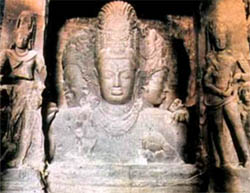| Elephanta Caves |
 |
| The most profound aspect of the mighty Shiva is in evidence at the Shiva temple in the Elephanta caves. Situated near Bombay, these caves present an introduction to some most exquisitely carved temples. One can witness a symphony in stone in praise of Lord Shiva, created by India's expert stone carvers of the sixth century.
|
 |
The central attraction here is a twenty-foot high bust of the deity in three-headed form. The Maheshamurti is built deep into a recess and looms up from the darkness to fill the full height of the cave.
This image symbolizes the fierce, feminine and meditative aspects of the great ascetic and the three heads represent Shiva as Aghori, Ardhanarishvara and Mahayogi. Aghori is the terrible form of Shiva where he is intent on destruction.
|
| Ardhanarishvara depicts Shiva as half-man/half-woman signifying the essential unity of the sexes. The Mahayogi posture symbolises the meditative aspect of the God and here Shiva is shown in his most quiet and serene form. Other sculptures in these caves depict Shiva's cosmic dance of primordial creation and destruction and his marriage to Parvati and Shiva as half man/half-woman. The Elephanta sculptures meaningfully convey the oneness of the human and the divine and the images transcend the scope of human imagination to achieve a grandeur that remains undiminished by time.
|
|
|
| Featured Paintings Gallery - Kalighat |
|
|
|
